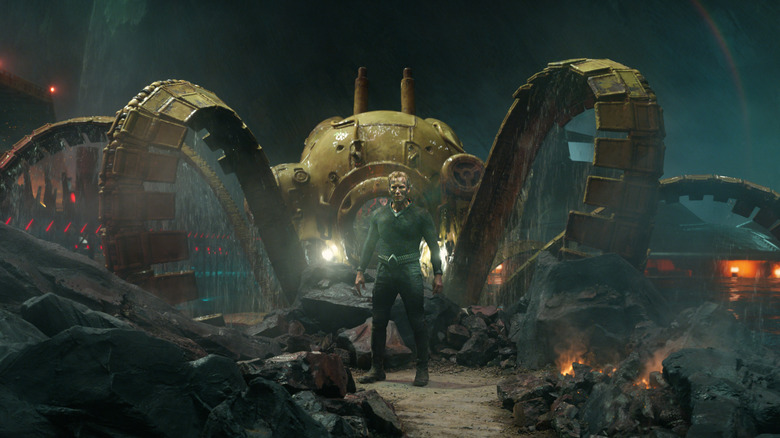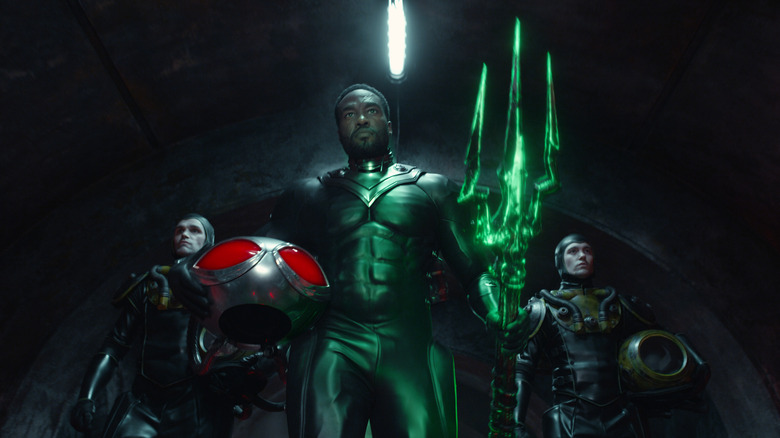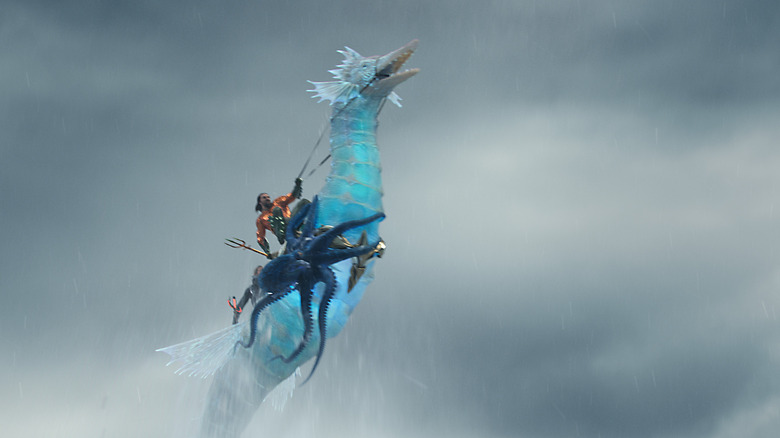Aquaman 2 Invented New VFX Rigs To Save The Cast From Extreme Pain
The sequel to "Aquaman," Warner Bros. and DC's surprising 2018 bombshell box office smash (which still holds the record as the company's highest-grossing film to date — sorry Batman!) is almost here after a long wait. Well, fans will have to wait a bit longer for that December 20, 2023 release date, after expecting the movie in December 2022 and then earlier this March. But hey, the juiced-up King of Atlantis more than proved to us in his original outing that he's worth the wait.
The first teaser for the long-awaited sequel dropped this past Sunday, promising the action-packed trailer we got today. Giant, leaping seahorses, Yahya Abdul-Mateen II promising to "kill Aquaman and destroy everything he holds dear," gargantuan underwater explosions crackling with green and purple fire — director James Wan seems to have upped the ante several degrees. Which is saying something, as the original "Aquaman" contains scenes and flourishes that rival Wan's most audacious exploits in films like "Malignant" and even his breakthrough, "Saw."
At an exclusive trailer reveal event attended by /Film's own Jenna Busch-Henderson, Wan gave some of his first in-depth remarks about the making of "Aquaman and the Lost Kingdom." One question concerned the advancement of visual and special effects, and Wan's answer lets us all breathe a sigh of relief for the actors who valiantly portray the royal Atlantic court and their enemies.
Freeing the actors from pain
It's the job of accomplished directors like James Wan to make zooming through deep water, launching out of it like a dolphin, and twisting your body to take and give hits look not only natural on screen, but easy for the actor to perform. A thought like, "Wow, that stunt sure looked hard for that actor" would be just as destructive for the film's believability as the though, "This VFX looks like crap." Making a movie like "Aquaman and the Lost Kingdom," then, isn't just about wrangling the best team of VFX and motion graphics artists in the biz, but about utilizing technology to make the actors' performances as naturalistic as possible.
Speaking at the trailer reveal event, Wan said that he saw "a huge leap in the effects" from "Aquaman" to "Lost Kingdom," but that wasn't the only change, or even the most important one. It was "even in the process of how we shoot the film." Wan continued:
"The actors had such a hard time shooting the first one. There was also this complex rigging we had to put them through, which is not the best for them when they have to act at the same time. Meanwhile they're in a lot of pain from these difficult riggings. So what's great about this one is that I could actually free them up from all of that. My special effects and visual effects team did a really great job hearing what I had to complain about form the first movie and basically helping me build a process on how to get the same thing that I want but without putting the actors through all of that, so therefore I could just get better performances from them."
Better technology, better performances, better movie all around.
Practical x digital
A video put together by the YouTube account Fame Focus in 2021 gave a behind-the-scenes look into what the rigging that Wan discussed looks like. When critics and audiences call out "bad VFX," or even discuss VFX in a neutral manner, they may be conflating it with entirely computer-generated graphic effects. Some purely digital trickery was surely employed in the making of "Aquaman" and "Lost Kingdom" to say, animate underwater hair convincingly. But the big setpieces in which Jason Momoa, Yahya Abdul-Mateen II, and Amber Heard race through water and trade fisticuffs (and trident bolts) are assembled through a combination of large-scale mechanical rigging, blue-screened stunt assistants physically maneuvering actors around the set, and digital effects.
Watching behind the scenes clips of Momoa and crew being careened around on what look like ferris wheels while wearing skin-tight costumes and being sprayed with water, you can understand what Wan meant when he said he wanted to "free them up from all of that."
And free them up he did. If you want to see how being unencumbered from the more painful rigging apparatuses impacted the core cast's performances, you can check out "Aquaman and the Lost Kingdom," heading to theaters on December 20, 2023. And if you can't wait that long, you can watch the new trailer again (and again).


